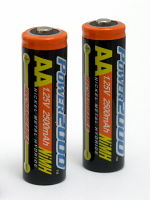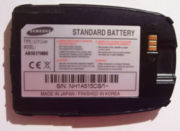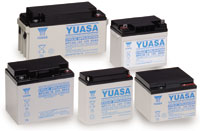All you need to know to keep your rechargeable batteries fit and well! It is often mentioned that keeping primary (disposable) or charged secondary (rechargable) batteries in the fridge will keep them fresher for longer. While this is, in the main, true they must be kept dry and not allowed to freeze.
Nickel-Cadmium (NiCd or NiCad). Nickel Metal Hydride (Ni-MH).
Lithium-ion (Li-ion). Lead Acid, including 'sealed'.

Batteries are ready to work in an instant (providing they are charged) and can be used over a wide temperature range. Charging, on the other hand, has limitations and the user should follow recommended guidelines on how and when to charge. Each battery chemistry has its own preferred charging method. Each type also has unique needs that must be met to obtain reliable service and long life.
Batteries behave like humans; some live to a great old age, others die early. Exposure to heat is the biggest enemy. Steps can be taken to prolong battery life but in the real world optimal handling may not always be practical. Deviations from the ideal are acceptable but will lower the life expectancy of the battery to some degree. This article summarises these needs and advises proper the handling of each battery type from purchase to 'bin'.

Nickel-Cadmium (NiCd or NiCad).
(The abbreviation NiCad is a registered trademark of SAFT Corporation and should not be used to refer generically to nickel-cadmium batteries, although this brand-name is commonly used to describe all nickel-cadmium batteries).

Voltage: 1.2V per cell. ('PP3' types are generally 7.2V although Varta made 8.4V batteries for more critical applications).
Capacity: Varies - dependent on size and construction technology.
Cycle durability: 2000 cycles
The nickel-cadmium battery (commonly abbreviated NiCd and pronounced "nye-cad") is a popular type of rechargeable battery using the nickel hydroxide (NiOH) and metallic cadmium (Cd) as the active chemicals.
Sealed NiCd cells may be used individually, or assembled into battery packs containing two or more cells. NiCd dry cells are manufactured in the same sizes as primary cells - AAA, AA, C & D, are often used for portable radios. When NiCds are substituted for primary cells, the lower terminal voltage and smaller amphour capacity may reduce performance over primary cells, if making your own 'pack' the voltage issue can be overcome by using 5 cells per 6V instead of the 4 cells per 6V of primaries, where space allows. NiCd is one of the most hardy and durable chemistries.
NiCd batteries have a very low internal resistance and, if the terminals are shorted, can 'dump' their whole charge very quickly with rapid and dangerous heat buildup and may even cause a fire or explosion. This low internal resistance gives them the edge in very high current drain applications such as cordless power tools and RC cars.
A major disadvantage (or advantage, depending on your views) is that a NiCd will deliver full voltage throughout its charge cycle but gives little warning of dscharge. This gives full output until the battery is 'dead', not very good for two way communications but cost made them a popular choice over primary (disposable) cells.
Charging:
Prime a new battery by putting on a 14-16 hour charge. Without priming the performance will be low at first, then gradually improve with use.
Important:
Rechargeable batteries can be used under a wide temperature range. This does not automatically permit charging at these extreme conditions.
The maximum allowable charge temperatures for NiCd are:
Slow charge: 0° - 45°C (32° - 113°F)
Fast charge: 5° - 45°C (41° - 113°F)
Charging a hot battery decreases the charge time and the battery may not fully charge.
Do run the battery fully down once per month. Try to use up all energy before charging.
Do not leave battery in charger for more than 2 days, a prolonged trickle charge to a fully charged battery can be harmful.
Avoid getting battery too hot during charging.
Always allow to fully charge without interruptions. Repeated partial charge can cause heat buildup. (Many chargers terminate charge by heat. A fully charged battery will re-heat, causing overcharge.)
Charge methods:
Constant current, if fast charge, follow with a trickle charge when full.Best results are achieved with a fast-charger that terminates the charge by other than temperature alone.
Discharging:
Full cycle does not harm NiCd.Service needs:
Discharge to 1V/cell every 1 to 2 months to prevent memory.Do not discharge before each charge.
Storage:
Manufacturers recommend a 40% charge for long storage. (Open terminal voltage cannot determine state-of-charge). Store in a cool place. Battery can be fully depleted and recharged. 5 years and longer storage possible. Prime battery if stored longer than 6 months.Disposal:
Do not dispose; contains toxic metals; must be re-cycled.
Nickel Metal Hydride (Ni-MH)

Voltage: 1.2V per cell. ('PP3' types are generally 8.4V).
Capacity: Varies - generally 2 to 3 times the capacity of a NiCd of the same size.
Cycle durability: 500-1000 cycles
The nickel metal hydride battery, abbreviated NiMH, pronounced 'Nimm', is a type of rechargeable battery similar to a nickel-cadmium (NiCd) battery but it has a hydrogen-absorbing alloy for the anode instead of cadmium.
Like the NiCd batteries, nickel is the cathode. The 'metal' in the anode of a NiMH battery is actually an intermetallic compound. Many different compounds have been developed for this application, but those in current use fall into two classes. The most common is AB5, where A is a rare earth mixture of lanthanum, cerium, neodymium, praseodymium and B is nickel, cobalt, manganese, and/or aluminum. Very few batteries use a higher-capacity negative material electrode based on AB2 compounds, where A is titanium and/or vanadium and B is zirconium or nickel, modified with chromium, cobalt, iron, and/or manganese, due to the reduced life performances.
A NiMH battery can have two to three times the capacity of an equivalent size NiCd and the memory effect is not as significant. NiMH batteries do not have as low an internal resistance as NiCd. NiMH cells are manufactured in the same sizes as primary cells - AAA, AA, C & D, are often used for handheld radio transceivers.
When NiMHs are substituted for primary cells, the lower terminal voltage may reduce performance over primary cells, if making your own 'pack' the voltage issue can be overcome by using 5 cells per 6V instead of the 4 cells per 6V of primaries, where space allows. NiMH has higher energy density than NiCd at the expense of shorter cycle life.
Charging:
Prime new battery by putting on a 14-16 hour charge, without priming the performance will be low at first, then gradually improve with use.Important:
Rechargeable batteries can be used under a wide temperature range. This does not automatically permit charging at these extreme conditions.
The maximum allowable charge temperatures for NiMH are:
Slow charge: 0° - 45°C (32° - 113°F)
Fast charge: 5° - 45°C (41° - 113°F)
Charging a hot battery decreases the charge time and the battery may not fully charge.
Do run the battery fully down once every 3 months. (Over-cycling is not advised.)
Do not leave battery in charger for more than 2 days, a prolonged trickle charge to a fully charged battery can be harmful.
Avoid getting battery too hot during charging.
Allow full charge without interruptions. Repeated partial charge can cause heat buildup. (Many chargers terminate charge by heat. A fully charged battery will re-heat, causing overcharge).
When fast-charging, it is advisable to charge NiMH batteries with a 'smart' battery charger to avoid overcharging, which can damage batteries and cause dangerous conditions. Some quick chargers have a fan to keep the batteries cool.
Charge methods:
Constant current, followed by trickle charge when full.Slow charge not recommended.
(Battery will get warm towards full charge).
Best results are achieved with a fast-charger that terminates the charge by other than temperature alone.
Discharging:
Avoid too many full cycles because of wear. Use 80% depth-of-discharge.Discharge to 1V/cell every 3 months to prevent memory.
Do not discharge before each charge.
Storage:
Store at 40% charge in a cool place. Open terminal voltage cannot determine state-of-charge. Prime battery if stored longer than 6 monthsDisposal:
Should be recycled. Low volume household NiMH may be disposed.
Lithium-ion (Li-ion)

Voltage: 3.7V per cell
Capacity: Varies - generally compairable to a NiCd of the same size.
Cycle durability: 1200 cycles
Lithium-ion batteries (sometimes abbreviated Li-ion batteries) were first proposed in the 1960s. The first commercial lithium ion battery was released by Sony in 1991.
They are commonly used in consumer electronics (mobile phones, personal MP3 players, laptop computers and some handheld radio transceivers). They are currently one of the most popular types of battery for portable electronics because they can be formed into a wide variety of shapes and sizes so as to efficiently fill available space in the devices they power. They have one of the best energy-to-weight ratios, no memory effect and a slow loss of charge when not in use which makes them a popular choice. They can be dangerous if mistreated and unless care is taken their lifespan may be reduced.
Note:
Lithium-ion batteries lose 5 to 10% of their storage capacity every year from the time of manufacture whether the battery is used or not!
Li-ion batteries are lighter than other equivalent secondary batteries, often much lighter. The energy is stored in these batteries through the movement of lithium ions. Lithium is the third lightest element, giving a substantial saving in weight compared to batteries using much heavier metals. However, the bulk of the electrodes are effectively "housing" for the ions and add weight, and in addition "dead weight" from the electrolyte, current collectors, casing, electronics and conductivity additives reduce the charge per unit mass to little more than that of other rechargeable batteries. The forte of the Li-ion chemistry is the high open circuit voltage in comparison to aqueous batteries (such as nickel cadmium, nickel metal hydride and lead acid).
Charging:
Li-ion comes partially charged. You can use the battery right away and charge it when needed. No priming required.Do charge the battery often. The battery lasts longer with partial rather than full discharges, it is better to recharge more often; avoid frequent full discharges.
Charging in stages is acceptable, full charge termination occurs by reading the voltage level and charge current. Charging a full battery is safe and does not cause harm.
The charger should automatically cut the charge current when the battery is full, so leaving the battery in the charger will not harm it.
Important:
Rechargeable batteries can be used under a wide temperature range. This does not automatically permit charging at these extreme conditions.
The maximum allowable charge temperatures for Li-ion are:
Slow charge 0° - 45°C (32° - 113°F)
Fast charge 5° - 45°C (41° - 113°F)
Temperature sensor may prevent charge or cut off the charge prematurely.
Do not use if pack gets hot during charge. Check also charger is correct.
Charge methods:
Constant voltage to 4.20V/cell (typical). No trickle-charge when full. Li-ion may remain in the charger.Battery must remain cool. No fast-charge possible, may cause explosion.
Charger should apply full charge. Avoid economy chargers that advertise one-hours charge.
Discharging:
Avoid full cycle because of wear. 80% depth-of-discharge recommended.Re-charge more often.
Avoid full discharge.
Low voltage may cut off safety circuit.
Storage:
Store at 40% charge in a cool place (40% state-of-charge reads 3.75-3.80V/cell at open terminal).Do not store at full charge and at warm temperatures because of accelerated aging.
Diposal:
Should be recycled. Low volume household Li-ion may be disposed.
Lead-acid (Sealed or flooded).

Voltage: typically 2.3V per cell, 6 or 12V (3 or 6 cell) batteries commonly available.
Capacity: Varies - dependant on physicial size.
Cycle durability: 200 to 300 cycles.
Lead-acid is the oldest rechargeable battery in existence. During the mid 1970s, researchers developed a maintenance-free lead-acid battery that could operate in any position. The liquid electrolyte was transformed into moistened separators and the enclosure was 'sealed', actually vented in case of gassing. It has retained a market share in applications where newer battery chemistries would either be too expensive or the upkeep would be too demanding. There are simply no cost-effective alternatives for such applications as cars and motorcycles (flooded) wheelchairs, scooters, golf carts and UPS systems ('sealed').
Driven by different market needs, two 'sealed' lead-acid systems emerged: the small sealed lead-acid (SLA), also known under the brand name of Gelcell, and the valve-regulated-lead-acid (VRLA). Technically, both batteries are the same. (Engineers may argue that the word 'sealed lead acid' is a misnomer because no rechargeable battery can be totally sealed).
Unlike the flooded lead acid battery, both SLA and VRLA are designed with a low over-voltage potential to prohibit the battery from reaching its gas-generating potential during charge. Excess charging would cause gassing and water depletion. The electrolyte in a 'sealed' type, obviously, cannot be topped up as a flooded battery can. Consequently, these batteries can never be charged to their full potential.
Charging:
Lead acid comes fully charged. For best result, apply a topping charge to assure full charge, otherwise no priming required.Do charge the battery immediately after use. Lead-acid must always be kept in a charged condition.
The battery lasts longer with partial rather than full discharges.
Over-cycling is not advised.
Flooded type may need occasional electrolyte top-up with de-ionised water if fluid level drops.
Important:
Rechargeable batteries can be used under a wide temperature range. This does not automatically permit charging at these extreme conditions.
The maximum allowable charge temperatures for Lead acid are:
Slow charge 0° - 45°C (32° - 113°F)
Fast charge 5° - 45°C (41° - 113°F).
Warm temperature lowers the battery voltage. Serious overcharge occurs if the cut-off voltage is not reached.
Charge methods:
Constant voltage to 2.40/cell (typical), followed by float held at 2.25V/cell.Battery must remain cool.
No fast-charge possible.
Can remain on float charge for unlimited time.
Multi-level charges shorten charge time. Charge must be fully saturated, failing to do so will gradually decrease the capacity.
If flooded type precaution against acid splash is essential.
Discharging:
Avoid full cycle because of wear.Use 80% depth-of-discharge.
If deep discharge occurs frequently, recharge more often or use a larger battery.
Storage:
Store always at a full state-of-charge.Do not store below 2.10V/cell.
Apply topping charge every 6 months. With flooded types check fluid level and top up as needed before charging.
Occasional discharge / charge may improve performance.
IMPORTANT: Always keep battery fully charged. A discharged battery causes sulfation (insulating layer in the cell). This condition is often irreversible.